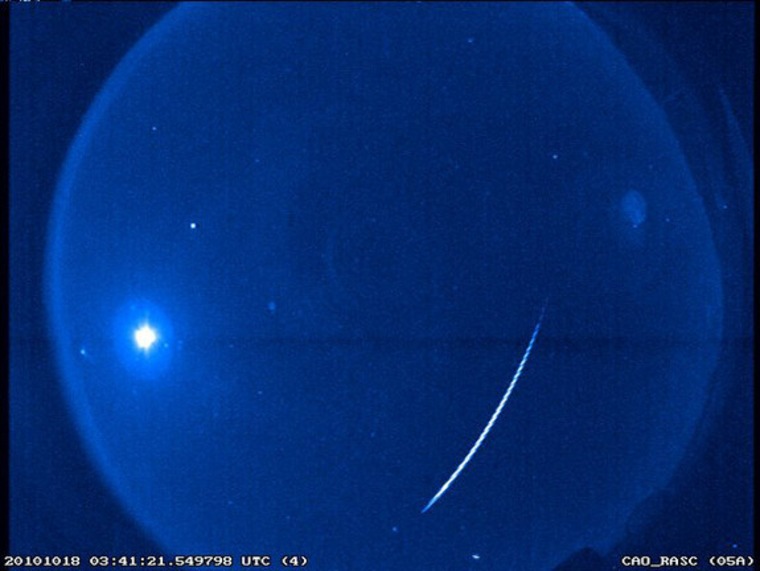If you step outside before dawn during the next week or so, you might try to catch a view of some "cosmic litter" that has been left behind in space by Halley's Comet: the Orionid meteor shower.
The Orionids can best be described as a junior version of the famous Perseid meteor shower. This year's Orionids show is scheduled to reach its maximum before sunrise on the morning of Oct. 22. The meteors are known as "Orionids" because the fireballs seem to fan out from a region to the north of Orion's second brightest star, ruddy Betelgeuse.
Currently, Orion appears ahead of us in our journey around the sun. The constellation does not completely rise above the eastern horizon until after 11 p.m. local daylight time. At its best, several hours later around 5 a.m., Orion will be highest in the sky toward the south.
The Orionids typically produce around 20 to 25 meteors per hour under a clear, dark sky. Orionid meteors are normally dim and not well seen from urban locations, so you'd do best to find a safe rural location to see the most Orionid activity. [ Spectacular Leonid meteor shower photos ]
Orionid meteors will begin to increase noticeably around Oct. 17, when they'll start appearing at about five per hour. After peaking on the morning of Oct. 22, activity will begin to slowly descend, dropping back to around five per hour around Oct. 26. The last stragglers usually appear sometime in early to mid- November.
Halley's Legacy
Halley's Comet has left a visible legacy in the form of these two annual meteor showers, one of which is the Orionids. This will be a good year to look for them, since the moon will have slimmed down to a crescent on the morning of the Orionids peak, and will not pose much of a hindrance for those watching for Orionids in 2011. This slender moon will not rise until around 2 a.m. local daylight time.
Comets are the leftovers of the solar system's creation, the odd bits and pieces of simple gases — methane, ammonia, carbon dioxide and water vapor — that went unused when the sun and its attendant planets came into their present form. Meteoroids that are released into space out of this debris are the remnants of a comet's nucleus. All comets eventually disintegrate into meteor swarms, and Halley's is well into that process already. [ Video: Meteors from Halley's Comet ]
These tiny particles — mostly ranging in size from dust to sand grains — remain along the original comet's orbit, creating a "river of rubble" in space. In the case of Halley's Comet, which has likely circled the sun many hundreds, if not thousands, of times, its dirty trail of debris has been distributed more or less uniformly all along its orbit. When these tiny bits of comet collide with Earth, friction with our atmosphere raises them to white heat and produces the effect popularly referred to as "shooting stars."
The orbit of Halley's Comet closely approaches the Earth's orbit at two places. One point is in the early part of May, producing a meteor display known as the Eta Aquarids. The other point comes in the middle to later part of October, producing the Orionids.
What to expect
The best time to watch begins from 1 or 2 a.m. local daylight time, until around dawn, when the shower's point of origin (in Orion's upraised club, just north of the bright red star, Betelgeuse) is highest above the horizon. The higher this point, called the radiant, the more meteors appear all over the sky.
The Orionids are one of just a handful of meteor showers that can be observed equally well from both the Northern and Southern hemispheres.
This meteor shower is one of the better annual displays, producing about 15 to 20 meteors per hour at its peak. Add the five to 10 sporadic meteors that always are plunging into our atmosphere and you get a maximum of about 20 to 30 meteors per hour for a dark sky location. Most of these meteors are relatively faint, however, so any light pollution will cut the total way down.
The shower may be quite active for several days before or after its broad maximum, which may last from Oct. 20 through Oct. 24. Step outside before sunrise on any of these mornings, and if you catch sight of a meteor, there's about a 75 percent chance that it likely originated from the nucleus of Halley's Comet.
"They are easily identified … from their speed," write David Levy and Stephen Edberg in "Observe: Meteors," an Astronomical League manual. "At 66 kilometers (41 miles) per second, they appear as fast streaks, faster by a hair than their sisters, the Eta Aquarids of May. And like the Eta Aquarids, the brightest of family tend to leave long-lasting trains. Fireballs are possible three days after maximum."
Recent studies have shown that about half of all Orionids that are seen leave trails that lasted longer than other meteors of equal brightness. This is undoubtedly connected in some way to the makeup of Halley's Comet. So it is that the shooting stars that we have come to call Orionids are really an encounter with the traces of a famous visitor from the depths of space and from the dawn of creation.
Joe Rao serves as an instructor and guest lecturer at New York's Hayden Planetarium. He writes about astronomy for The New York Times and other publications, and he is also an on-camera meteorologist for News 12 Westchester, New York.
